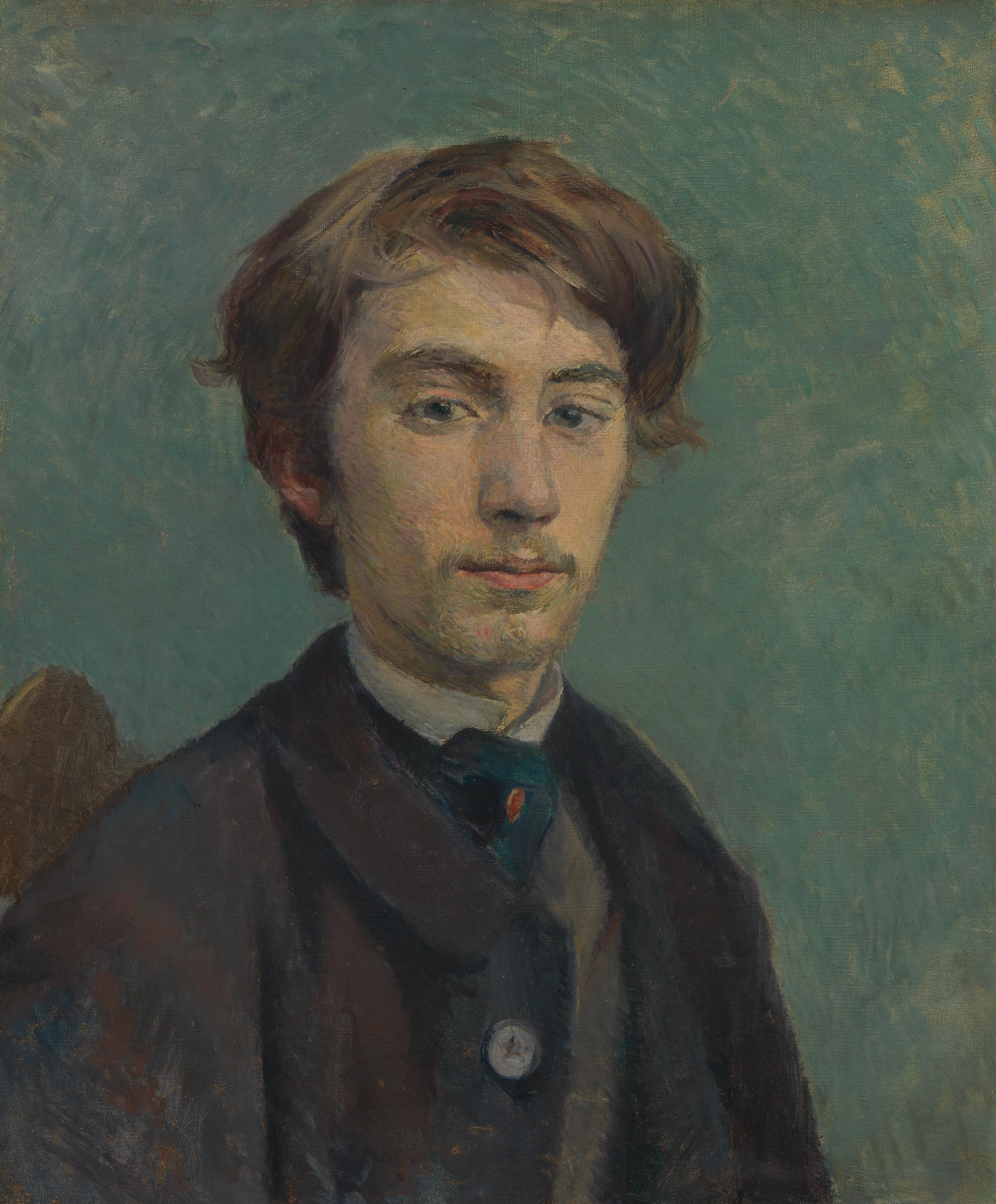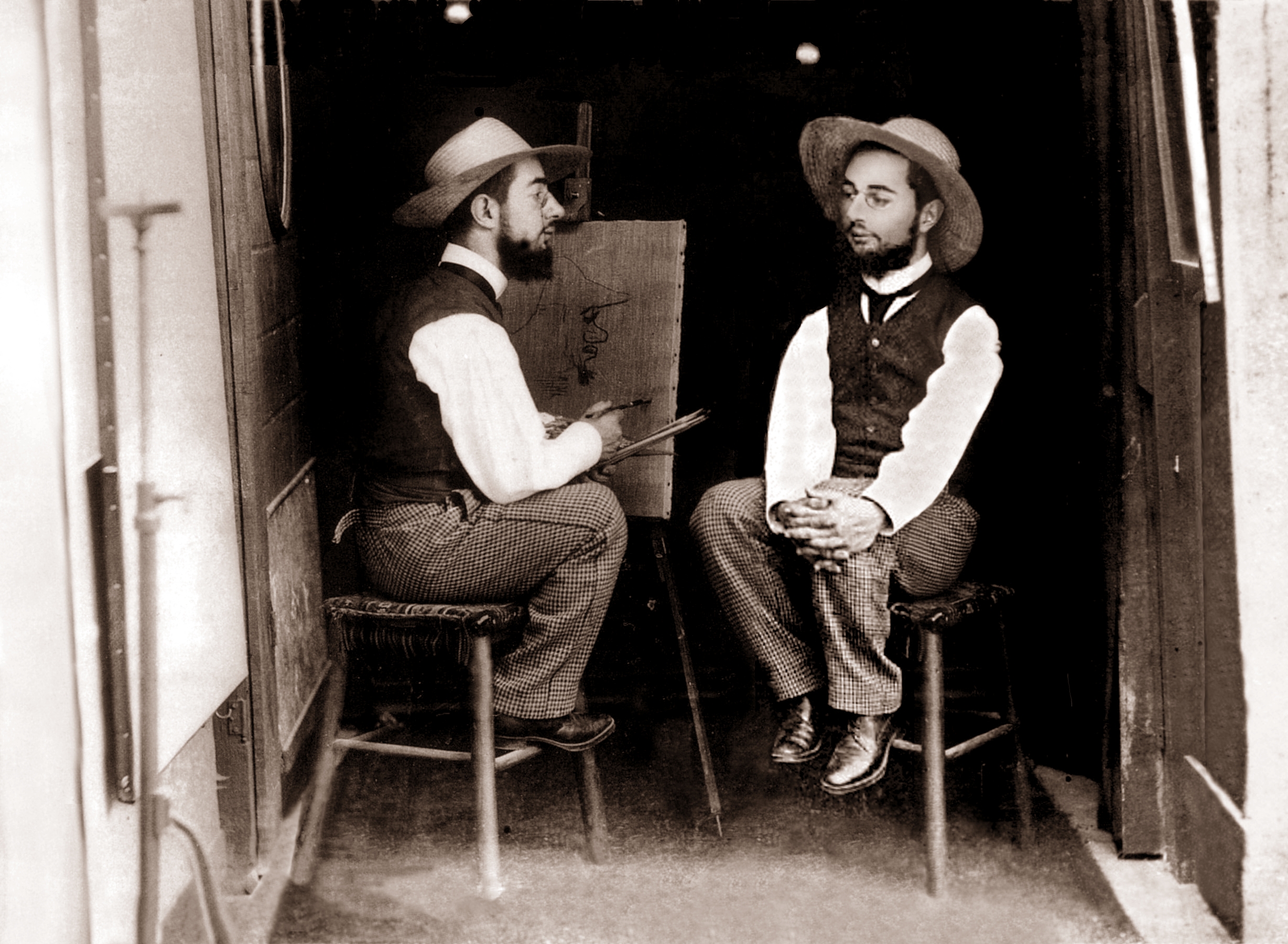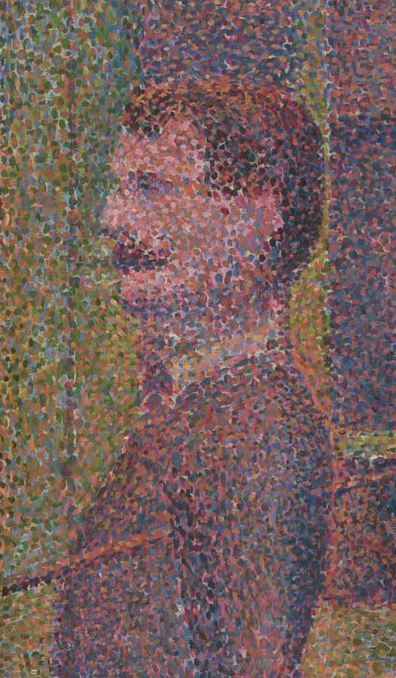|
Émile Bernard (painter)
Émile Henri Bernard (28 April 1868 – 16 April 1941) was a French Post-Impressionist painter and writer, who had artistic friendships with Vincent van Gogh, Paul Gauguin and Eugène Boch, and at a later time, Paul Cézanne. Most of his notable work was accomplished at a young age, in the years 1886 through 1897. He is also associated with Cloisonnism and Synthetism, two late 19th-century art movements. Less known is Bernard's literary work, comprising plays, poetry, and art criticism as well as art historical statements that contain first-hand information on the crucial period of modern art to which Bernard had contributed. Biography Émile Henri Bernard was born in Lille, France, in 1868. As in his younger years his sister was sick, Émile was unable to receive much attention from his parents; he therefore stayed with his grandmother, who owned a laundry in Lille, employing more than twenty people. She was one of the greatest supporters of his art. The family moved to Par ... [...More Info...] [...Related Items...] OR: [Wikipedia] [Google] [Baidu] |
Lille
Lille ( , ; nl, Rijsel ; pcd, Lile; vls, Rysel) is a city in the northern part of France, in French Flanders. On the river Deûle, near France's border with Belgium, it is the capital of the Hauts-de-France Regions of France, region, the Prefectures in France, prefecture of the Nord (French department), Nord Departments of France, department, and the main city of the Métropole Européenne de Lille, European Metropolis of Lille. The city of Lille proper had a population of 234,475 in 2019 within its small municipal territory of , but together with its French suburbs and exurbs the Lille metropolitan area (French part only), which extends over , had a population of 1,510,079 that same year (Jan. 2019 census), the fourth most populated in France after Paris, Lyon, and Marseille. The city of Lille and 94 suburban French municipalities have formed since 2015 the Métropole Européenne de Lille, European Metropolis of Lille, an Indirect election, indirectly elected Métropole, metr ... [...More Info...] [...Related Items...] OR: [Wikipedia] [Google] [Baidu] |
Modern Art
Modern art includes artistic work produced during the period extending roughly from the 1860s to the 1970s, and denotes the styles and philosophies of the art produced during that era. The term is usually associated with art in which the traditions of the past have been thrown aside in a spirit of experimentation. Modern artists experimented with new ways of seeing and with fresh ideas about the nature of materials and functions of art. A tendency away from the narrative, which was characteristic for the traditional arts, toward abstraction is characteristic of much modern art. More recent artistic production is often called contemporary art or postmodern art. Modern art begins with the heritage of painters like Vincent van Gogh, Paul CĂ©zanne, Paul Gauguin, Georges Seurat and Henri de Toulouse-Lautrec all of whom were essential for the development of modern art. At the beginning of the 20th century Henri Matisse and several other young artists including the Proto-Cubism, pre-c ... [...More Info...] [...Related Items...] OR: [Wikipedia] [Google] [Baidu] |
Watercolor
Watercolor (American English) or watercolour (British English; see spelling differences), also ''aquarelle'' (; from Italian diminutive of Latin ''aqua'' "water"), is a painting method”Watercolor may be as old as art itself, going back to the Stone Age when early ancestors combined earth and charcoal with water to create the first wet-on-dry picture on a cave wall." London, Vladimir. The Book on Watercolor (p. 19). in which the paints are made of pigments suspended in a water-based solution. ''Watercolor'' refers to both the medium and the resulting artwork. Aquarelles painted with water-soluble colored ink instead of modern water colors are called ''aquarellum atramento'' (Latin for "aquarelle made with ink") by experts. However, this term has now tended to pass out of use. The conventional and most common ''support''—material to which the paint is applied—for watercolor paintings is watercolor paper. Other supports or substrates include stone, ivory, silk, reed, papy ... [...More Info...] [...Related Items...] OR: [Wikipedia] [Google] [Baidu] |
Arles
Arles (, , ; oc, label= Provençal, Arle ; Classical la, Arelate) is a coastal city and commune in the South of France, a subprefecture in the Bouches-du-Rhône department of the Provence-Alpes-Côte d'Azur region, in the former province of Provence. A large part of the Camargue, the largest wetlands in France, is located on the territory of the commune, making it the largest commune in Metropolitan France in terms of geographic territory. (Maripasoula, French Guiana, is much larger than Arles). The city has a long history, and was of considerable importance in the Roman province of Gallia Narbonensis. The Roman and Romanesque Monuments of Arles were listed as UNESCO World Heritage Sites in 1981 for their testimony to the history of the region. Many artists have lived and worked in this area because of the southern light, including Pablo Picasso, Paul Gauguin, Jacques Réattu, and Peter Brown. The Dutch post-Impressionist painter Vincent van Gogh lived in Arles from 1888 ... [...More Info...] [...Related Items...] OR: [Wikipedia] [Google] [Baidu] |
Modern Art
Modern art includes artistic work produced during the period extending roughly from the 1860s to the 1970s, and denotes the styles and philosophies of the art produced during that era. The term is usually associated with art in which the traditions of the past have been thrown aside in a spirit of experimentation. Modern artists experimented with new ways of seeing and with fresh ideas about the nature of materials and functions of art. A tendency away from the narrative, which was characteristic for the traditional arts, toward abstraction is characteristic of much modern art. More recent artistic production is often called contemporary art or postmodern art. Modern art begins with the heritage of painters like Vincent van Gogh, Paul CĂ©zanne, Paul Gauguin, Georges Seurat and Henri de Toulouse-Lautrec all of whom were essential for the development of modern art. At the beginning of the 20th century Henri Matisse and several other young artists including the Proto-Cubism, pre-c ... [...More Info...] [...Related Items...] OR: [Wikipedia] [Google] [Baidu] |
Académie Julian
The Académie Julian () was a private art school for painting and sculpture founded in Paris, France, in 1867 by French painter and teacher Rodolphe Julian (1839–1907) that was active from 1868 through 1968. It remained famous for the number and quality of artists who attended during the great period of effervescence in the arts in the early twentieth century. After 1968, it integrated with . History Rodolphe Julian established the Académie Julian in 1868 at the Passage des Panoramas, as a private studio school for art students.Tate Gallery"Académie Julian."/ref> The Académie Julian not only prepared students for the exams at the prestigious École des Beaux-Arts, but offered independent alternative education and training in arts. "Founded at a time when art was about to undergo a long series of crucial mutations, the Academie Julian played host to painters and sculptors of every kind and persuasion and never tried to make them hew to any one particular line". In 1880, wo ... [...More Info...] [...Related Items...] OR: [Wikipedia] [Google] [Baidu] |
Pont-Aven
Pont-Aven (, Breton: 'River Bridge') is a commune in the Finistère department in the Brittany region in Northwestern France. In 2019, it had a population of 2,821. Demographics Inhabitants of Pont-Aven are called ''Pontavenistes'' in French. Pont-Aven absorbed the former commune of Nizon in 1954, which had a population of 1,837 at the time. Map History Pont-Aven is mentioned among the towns which took part in the Breton anti-tax Rebellion of the Red Bonnets against Louis XIV of France in 1675. Arts Pont-Aven is mainly known because of the group of artists who flocked round Émile Bernard and Paul Gauguin, and who were joined in 1888 by Paul Sérusier. They were collectively known as "Pont-Aven School" (French: ''École de Pont-Aven'', Breton: ''Skol Pont-Aven''). Pont Aven School of Contemporary Art (PASCA) is an international fine arts program located in the historic artists' colony of Pont-Aven (Brittany, France). The student body is made up of third-year uni ... [...More Info...] [...Related Items...] OR: [Wikipedia] [Google] [Baidu] |
Brittany
Brittany (; french: link=no, Bretagne ; br, Breizh, or ; Gallo language, Gallo: ''Bertaèyn'' ) is a peninsula, Historical region, historical country and cultural area in the west of modern France, covering the western part of what was known as Armorica during the period of Roman occupation. It became an Kingdom of Brittany, independent kingdom and then a Duchy of Brittany, duchy before being Union of Brittany and France, united with the Kingdom of France in 1532 as a provinces of France, province governed as a separate nation under the crown. Brittany has also been referred to as Little Britain (as opposed to Great Britain, with which it shares an etymology). It is bordered by the English Channel to the north, Normandy to the northeast, eastern Pays de la Loire to the southeast, the Bay of Biscay to the south, and the Celtic Sea and the Atlantic Ocean to the west. Its land area is 34,023 km2 . Brittany is the site of some of the world's oldest standing architecture, ho ... [...More Info...] [...Related Items...] OR: [Wikipedia] [Google] [Baidu] |
Henri De Toulouse-Lautrec
Comte Henri Marie Raymond de Toulouse-Lautrec-Monfa (24 November 1864 – 9 September 1901) was a French painter, printmaker, draughtsman, caricaturist and illustrator whose immersion in the colourful and theatrical life of Paris in the late 19th century allowed him to produce a collection of enticing, elegant, and provocative images of the sometimes decadent affairs of those times. Born into the aristocracy, Toulouse-Lautrec broke both his legs around the time of his adolescence and, due to the rare condition Pycnodysostosis, was very short as an adult due to his undersized legs. In addition to his alcoholism, he developed an affinity for brothels and prostitutes that directed the subject matter for many of his works recording many details of the late-19th-century bohemian lifestyle in Paris. Toulouse-Lautrec is among the painters described as being Post-Impressionists, with Paul Cézanne, Vincent van Gogh, Paul Gauguin, and Georges Seurat also commonly considered as ... [...More Info...] [...Related Items...] OR: [Wikipedia] [Google] [Baidu] |
Louis Anquetin
Louis Émile Anquetin (26 January 1861 – 19 August 1932) was a French painter. Biography Anquetin was born in Étrépagny, France, and educated at the Lycée Pierre Corneille in Rouen. In 1882 he came to Paris and began studying art at Léon Bonnat's studio, where he met Henri de Toulouse-Lautrec. The two artists later moved to the studio of Fernand Cormon, where they befriended Émile Bernard and Vincent van Gogh. Around 1887, Anquetin and Bernard developed a painting style that used flat regions of color and thick, black contour outlines. This style, named ''cloisonnism'' by critic Édouard Dujardin, was inspired by both stained glass and Japanese ukiyo-e. One example of this can be seen in ''Avenue de Clichy: Five O’Clock in the Evening'', argued by Dr. Bogomila Welsh-Ovcharov as being inspiration for Van Gogh's famous '' Cafe Terrace at Night''.Welsh-Ovcharov, Bogomila: ''Vincent van Gogh and the Birth of Cloisonism'' (!), Art Gallery of Ontario, Toronto, 24 January ... [...More Info...] [...Related Items...] OR: [Wikipedia] [Google] [Baidu] |
Pointillism
Pointillism (, ) is a technique of painting in which small, distinct dots of color are applied in patterns to form an image. Georges Seurat and Paul Signac developed the technique in 1886, branching from Impressionism. The term "Pointillism" was coined by art critics in the late 1880s to ridicule the works of these artists, but is now used without its earlier pejorative connotation. The movement Seurat began with this technique is known as Neo-impressionism. The Divisionism, Divisionists used a similar technique of patterns to form images, though with larger cube-like brushstrokes. Technique The technique relies on the ability of the eye and mind of the viewer to blend the color spots into a fuller range of tones. It is related to Divisionism, a more technical variant of the method. Divisionism is concerned with color theory, whereas pointillism is more focused on the specific style of brushwork used to apply the paint. It is a technique with few serious practitioners today an ... [...More Info...] [...Related Items...] OR: [Wikipedia] [Google] [Baidu] |






.jpg)



